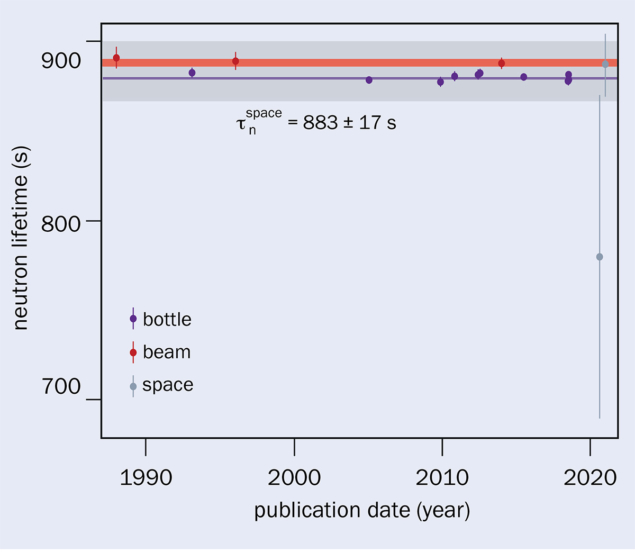
The neutron lifetime is key to a range of fields, not least astrophysics and cosmology, where it is used in the modeling of the synthesis of helium and heavier elements in the early universe. Its value, however, is uncertain. In recent years, discrepancies of up to 4σ between measurements of the neutron lifetime using different methods present a puzzle that particle physicists, nuclear physicists and cosmologists are increasingly eager to solve.
A recent experiment with the UCNτ experiment at the Los Alamos Neutron Science Center, which resulted in the most constraining measurement of the lifetime to date, further strengthens the discrepancy. The latest result, achieved using the so called “bottle” method, results in a neutron lifetime of 877.75 ± 0.28 (stat) +0.22 –0.16 (syst) s, whereas measurements using the “beam” method have consistently resulted in longer lifetimes (see figure). While the beam method determines the lifetime by measuring the decay products of the neutron, the bottle method instead stores cold, or thermalised, neutrons for a certain time before counting the remaining ones by direct detection. If not the result of some unknown systematic error, the discrepancy could be a sign of exotic physics whereby the longer lifetime in the beam method stems from an unmeasured second decay channel.
Escape detection
Astrophysics brings a third, independent measurement into play based on the bombardment of galactic cosmic rays on planetary surfaces. This continual process liberates large numbers of high-energy neutrons, some of which escape into space while others approach thermal equilibrium with surface and atmospheric material, a proportion subsequently escaping into space where at some point they will decay. The neutron lifetime can therefore be inferred by counting the neutrons remaining at different distances from their production location, using detectors positioned hundreds to thousands of kilometres above the surface. As the escaped neutron flux depends on a planet’s particular elemental composition at depths corresponding to the neutron mean-free path (typically around 10 cm), neutron spectrometers have already been installed on several missions to explore planetary surface compositions.
A dedicated instrument on a future lunar mission could bring a crucial third independent tool to tackle the neutron lifetime puzzle
In 2020, using neutrons produced through interactions of cosmic rays with Venus and Mercury, a team from the Johns Hopkins Applied Physics Laboratory and Durham University demonstrated the feasibility of such a neutron-lifetime measurement. Now, using data from a lunar mission, the same team has provided the first results with uncertainties approaching those coming from lab-based experiments. Importantly, since it also relies on direct detection, the result from space should produce the same lifetime as the bottle experiments.
For this latest study, the researchers used data from NASA’s Lunar Prospector taken during several elliptical orbits around the moon in 1998. The orbiter contained two neutron detectors, one with a cadmium shield making it insensitive to slow or thermal neutrons, and one containing a tin shield that allows it to measure thermal as well as higher- energy neutrons. The difference between the two count rates then provides the thermal neutron flux. Combining this with the spacecraft position, the group deduced the thermal neutron flux for different positions and distances towards the Moon and fitted the data against a model that includes the production and propagation of thermal neutrons originating from interactions of cosmic rays with the lunar surface.
Surface studies
The highly detailed models account for neutron production from cosmic-ray interactions with the different elements of the lunar surface, and also for the varying composition of the surface in different regions. For the lifetime measurement, thermal neutrons were used due to their lower velocities (a few km/s), which makes their flux as a function of the distance to the surface (typically several 100 km) more sensitive to their lifetimes. The higher sensitivity comes at the cost of greater model complexity, however. For example, thermal neutrons cannot simply be modeled as traveling in a straight line, but are affected by the lunar gravity, meaning that they not only come directly from the surface but also enter the detector from the back as they perform elliptical orbits.
The study found a lifetime of 887 ± 14 (stat) +7–3 (syst) s. The systematic error stems mainly from uncertainties in the surface composition and its variations as well as a lack of modeling of the temperature variation of the Moon’s surface, which affects the thermalisation process, and from uncertainties in the ephermides (location) of the spacecraft. In future dedicated missions, the latter two issues can be mitigated, while knowledge of the surface composition can be improved with additional studies. Indeed, the large statistical error arises from this being a non-dedicated mission where the small data sample used was not even part of the science data of the original mission. The results are therefore highly promising, as they show that a dedicated instrument on a future lunar mission would bring a crucial third independent tool to tackle the neutron lifetime puzzle.
Further reading
J T Wilson et al. 2021 Phys. Rev. C 104 045501.
UCNτ Collab. 2021 Phys. Rev. Lett. 127 162501.





